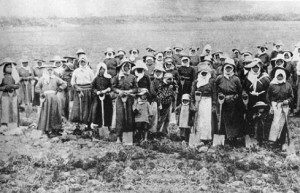THE JAPANESE ARRIVE IN CUBA WITH THEIR SAMURAIS, NINJAS, AND THE TELEVISION TELE SERIE “OSHIN”. VIDEOS.
In the 1960s onwards, we Cubans were happy if we managed to have any Japanese article, in particular electrical appliances, and Sony, Sanyo, JVC, Panasonic, Toshiba, Sharp, Hitachi; Casio, Citizen or Seiko watches; Nikon, Canon or Olympus cameras, and even though we didn’t have them, we all admire the auto industry with Nissan, Toyota, Mitsubishi, Suzuki, Mazda, and Honda.
And in parallel, and in a massive way, came the stories of samurai and ninjas. It was thus that Akira Kurosawa with his favorite actor Toshiro Mifune became one of the favorites. ‘Rashomon’, ‘The Seven Samurais’,’ Sanshiro Sugata ‘(or the Legend of Judo, one of my favorites),’ Throne of Blood ‘(the Japanese McBeth),’ Yojimbo ‘,’ Sanjuro ‘, and the Fortress Escondida ‘, they were great successes. At the same time other works by Masaki Kobayashi appeared, such as the excellent ‘Harakiri’ and the ‘Rebellion of the Samurai’. And then the successful series of more than 20 films by ‘Ichi’ (or Zatoichi), the blind swordsman and masseur, which made everyone’s delight.
Impressive works in the form of serials also reached television, such as the unforgettable ‘Oshin’, which portrays Japan from the early 19th century to the 80s. Samurai films showed us a good part of the history of the millennial country, but Oshin shows us contemporary Japan and how the country has evolved into the most perfect nation that it is.
“OSHIN”, THE JAPANESE SERIES THAT SHOCKED CUBA
In 1990, a Japanese soap opera entered Cuban homes and made everyone cry from the first chapters. It told the story of a woman born in the ‘Meiji’ (Worship of the Rules) era, but not in the palaces of the emperor of Japan, but in a humble country house.
Oshin was the name of this Japanese television series that was broadcast by Cubavisión. It was produced by the public television network NHK and premiered in Japan in 1983. It had 297 episodes of 15 minutes each and ran for a year.
The story ‘Oshin’ is based on the life of Katsu Wada, mother of Japanese businessman Kazuo Wada, founder of the Yaohan supermarket chain. The production of this series was about to be banned. This is because it narrated events that occurred in the Meiji era, a historical period difficult for the Japanese to fit in, which lasted between 1868 and 1912.
At this point, the life of Oshin, a girl born in 1900, begins to be narrated. Oshin Tanokura decides to take a train ticket to rediscover her story.
The series begins with the disappearance of an 83-year-old businesswoman who fails to comply with an important public event organized by her family. She is absent from the opening of one of the supermarkets they run and this causes great confusion for those close to her. One of her grandchildren is about to find her grandmother. Once they are together they start the journey back home and on the way, Oshin begins to tell the memories of her life from the age of 7.
What follows is a harrowing story of effort and continual self-improvement. But, beyond an isolated example, the series deals with the lives of thousands of Japanese women, represented in the childhood, maturity, and old age of a character.
Oshin is a symbol of perseverance. Perhaps her greatest legacy is her teaching never to give up on a dream, to be honest, and to work till you drop, even at times when life seems meaningless.
The series captivated the population of 67 countries in which it was broadcast. Her name was adopted for things as dissimilar as a rice-based diet, a cruise line, the pseudonym of a sportsman, or the name of housemaids.
THE FIRST JAPANESE ARRIVE IN CUBA
The Diario de la Marina reported that on September 9, 1898, the first Japanese arrived in Cuba with plans to settle on the island, to foster a community, which had more than a thousand Japanese immigrants who arrived in the steam ‘Orizawa ‘who had left Veracruz in Mexico.
Japanese emigration to Cuba amounted to a few hundred people, it was not as massive as in Brazil, Argentina, and Peru and it was mainly made up of men, those who formed families with Cubans and who, as a great impediment, had to adapt to the local diet. , because many ingredients of their eating habits are not available on the Island.
Despite being few, they were also dispersed throughout the national territory, although there were attempts to group together, among which the one created in 1914 by Kogawa Fujishiro in the Central Constancia, in Abreus, Las Villas, today the province of Cienfuegos and in 1920 It is repeated in Cienfuegos with other immigrants, the most important was the one created in Isla de Pinos, where they founded the first known agricultural production cooperative in Cuba, as well as the introduction of chemical fertilizers.
The Japanese also founded the “Japanese Society of Cuba” and the “Japanese Society for Instruction and Recreation Showa” (Showa in Japanese means “Enlightened Peace”), both in Havana.
LLEGAN LOS JAPONESES A CUBA CON SUS HISTORIETAS DE SAMURAIS, NINJAS Y LA TELE SERIE “OSHIN”. VIDEOS.
En los años 1960s en adelante, los cubanos nos sentíamos felices si lográbamos tener algún artículo japonés, en particular electrodomésticos, y Sony, Sanyo, JVC, Panasonic, Toshiba, Sharp, Hitachi; los relojes Casio, Citizen o Seiko; las cámaras Nikon, Canon o Olympus, y aunque no los teníamos, todos admiramos la industria automotriz con Nissan, Toyota, Mitsubishi, Suzuki, Mazda y Honda.
Y paralelamente, y en forma masiva, llegaron las historias de samuráis y ninjas. Fue así que Akira Kurosawa con su actor preferido Toshiro Mifune, se convirtió en uno de los preferidos. ‘Rashomon’, ‘Los Siete Samurais’, ‘Sanshiro Sugata’ (o le Leyenda del Judo, una de mis preferidas), ‘Trono de Sangre’ (el McBeth japonés), ‘Yojimbo’, ‘Sanjuro’,y ‘la Fortaleza Escondida’, fueron grandes éxitos. Paralelamente aparecieron otras obras de Masaki Kobayashi, como la excelente ‘Harakiri’ y la ‘Rebelión de los Samuráis’. Y después la exitosa serie de más de 20 películas de ‘Ichi’ (o Zatoichi), el espadachín y masajista ciego, las que hicieron las delicias de todos.
También llegaron a la televisión obras impactantes en forma de seriales, como la inolvidable ‘Oshin’, que retrata al Japón desde principios del siglo XIX hasta los años 80. Las películas de samurais nos mostraron una buena parte de la historia del milenario país, pero Oshin nos muestra el Japón contemporánea y como el país ha evolucionado hasta ser la nación casi perfecta que es.
“OSHIN”, LA SERIE JAPONESA QUE CONMOVIÓ A CUBA
En el año 1990 una teleserie japonesa entró en los hogares cubanos y puso a todo el mundo a llorar desde los primeros capítulos. Contaba la historia de una mujer nacida en la era ‘Meiji’ (Culto a las reglas), pero no en los palacios del emperador de Japón, sino en una humilde casa rural.
Oshin fue el nombre de esta teleserie japonesa que fue transmitida por Cubavisión y estuvo producida por la cadena de televisión pública ‘NHK’ estrenada en Japón en 1983. Tuvo 297 episodios de 15 minutos cada uno y se transmitió durante un año.
La historia ‘Oshin” está basada en la vida de Katsu Wada, madre del empresario japonés Kazuo Wada, fundador de la cadena de supermercados Yaohan. La realización de esta serie estuvo a punto de ser vetada. Esto se debe a que narraba sucesos acaecidos en la era Meiji, un período histórico difícil de encajar por los japoneses, que se extendió entre 1868 y 1912.
En este punto comienza a narrarse la vida de Oshin una niña nacida en 1900. Oshin Tanokura decide tomar un boleto de tren para reencontrarse con su historia.
La serie comienza con la desaparición de una empresaria de 83 años que incumple con un importante acto público organizado por su familia. Se ausenta de la inauguración de uno de los supermercados que regentan y esto causa gran confusión para sus allegados. Uno de sus nietos se dispone a encontrar a la abuela. Una vez están juntos emprenden el viaje de regreso a casa y durante el camino Oshin comienza a contar sus recuerdos de vida a partir de los 7 años.
Lo que sigue es una desgarradora historia de esfuerzo y superación personal continua. Pero, más allá de un ejemplo aislado, la serie trata sobre la vida de miles de mujeres japonesas, representadas en la infancia, madurez y vejez de un personaje.
Oshin es un símbolo de la perseverancia. Su mayor legado quizás es la enseñanza de nunca renunciar a un sueño, ser honrado y trabajar hasta el cansancio, incluso en los momentos en que la vida parece que no tiene sentido.
Ademas de Cuba la Tele Serie “Oshin” cautivó a la población de 67 países en que fue transmitida. Su nombre fue adoptado para cosas tan disimiles como una dieta a base de arroz, una línea de cruceros, el seudónimo de un deportista, o la forma de llamar a las empleadas domésticas.
LLEGAN LOS PRIMEROS JAPONESES A CUBA
Reportaba el Diario de la Marina que el 9 de septiembre de 1898 llegó a Cuba el primer japonés con planes de establecerse en la isla, para fomentar una comunidad , la cual contó con más de un millar de inmigrantes nipones que llegaron en el vapor ‘Orizawa’ que había partido de Veracruz en México.
La emigración japonesa a Cuba llegó a sumar unos centenares de personas, y no fue tan masiva como en Brasil, Argentina y Perú y estaba compuesta mayoritariamente por hombres, los que formaron familia con cubanas y que como gran impedimenta, tuvieron que adaptarse a la dieta local, porque muchos ingredientes de sus hábitos alimenticios no se consiguen en la Isla.
A pesar de ser pocos, también se dispersaron por todo el territorio nacional, aunque existieron intentos de agruparse, entre las que destacan la creada en 1914 por Kogawa Fujishiro en el Central Constancia, en Abreus, Las Villas, hoy provincia de Cienfuegos y en 1920 se repite en Cienfuegos con otros inmigrantes, pero la más importante fue la creada en Isla de Pinos, donde fundaron la primera cooperativa de producción agrícola que se conozca en Cuba, así como propiciaron la introducción de fertilizantes químicos.
También los japoneses fundaron la “Sociedad Japonesa de Cuba” y la “Sociedad Japonesa de Instrucción y Recreo Showa” (Showa en japonés significa “Paz Iluminada”), ambas en La Habana.
Agencies/ MemoriasCubanas/ Carlos RodriguezB. / Gretchen Sánchez/ Internet Photos/ Arnoldo Varona/ VIDEOS – PHOTOS – LA HISTORIA DE CUBA
THE CUBAN HISTORY, HOLLYWOOD.











